The Telecom Regulatory Authority of India on Thursday released recommendations for the revision of the national numbering plan. This plan provides the rules and guidelines for assigning numbers to telecommunication services.
In today’s interconnected digital landscape, where billions of devices and users must be addressed, the availability and efficient use of numbering resources are critical for ensuring universal access and reliable delivery of telecommunication services to consumers, businesses, and industries, the regulator has said.
One of the primary changes proposed by the telecom regulator pertains to the transition to a 10-digit numbering system for landline or fixed-line phones. In addition, the regulator has proposed that landline-to-landline calls should be made with ‘0’ prefix, followed by the STD code of the area, followed by the subscriber’s number. The regulator has given the Department of Telecommunications six months to implement the change.
“The dialling pattern for fixed-to-mobile, mobile-to-fixed, and mobile-to-mobile calls will remain unchanged,” the TRAI has said.
The regulator has also hinted at its plans to introduce mobile number portability for landlines, as is available for mobile phones, once the changes are in place.
Moreover, the TRAI has also urged the DoT to implement its recommendations on the introduction of the calling name presentation feature, or CNAP. This, the regulator has said, should be implemented immediately. CNAP is commonly referred to as caller ID.
As far as inactive numbers are concerned, the TRAI has said that no mobile or fixed-line connections shall be deactivated by the telecom providers until 90 days of the non-usage period expire. If, however, a number stays inactive for a complete year after the 90-day period has passed, the same shall be deactivated.



